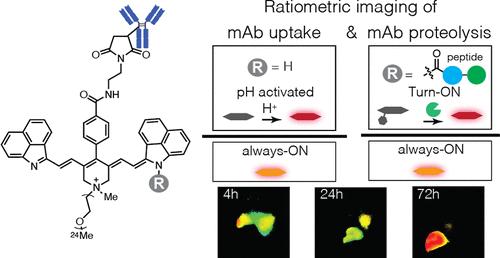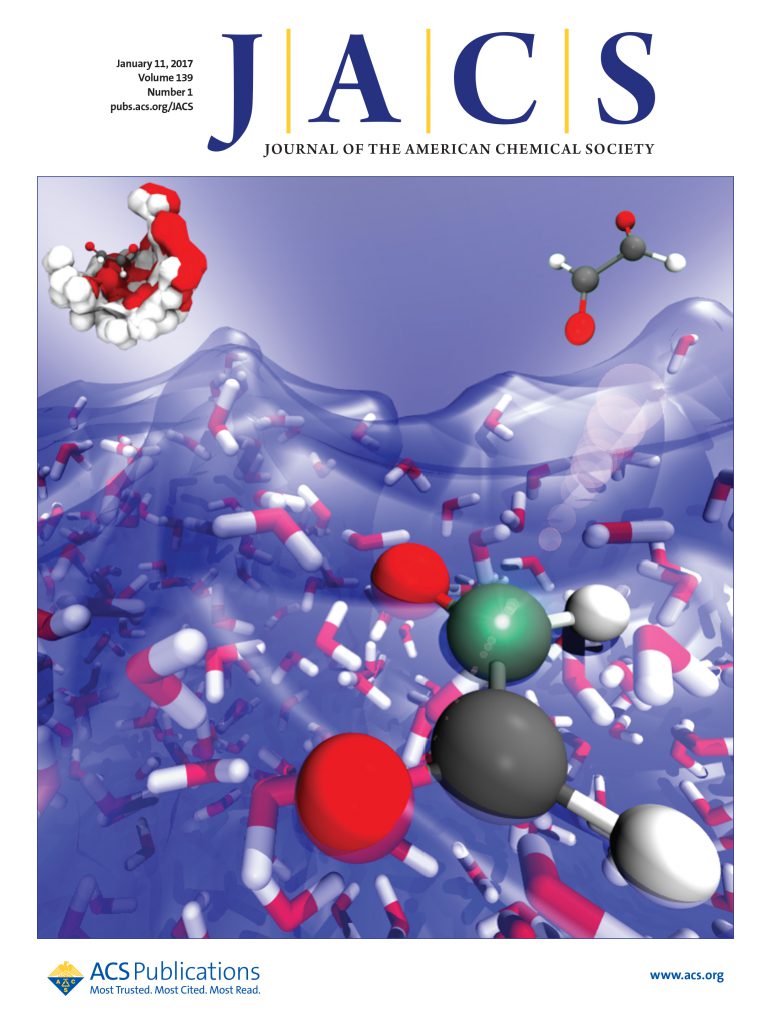Tracking the Fate of Therapeutic Proteins Using Ratiometric Imaging of Responsive Shortwave Infrared Probes
IF 14.4
1区 化学
Q1 CHEMISTRY, MULTIDISCIPLINARY
引用次数: 0
Abstract
Monoclonal antibodies (mAbs) are essential agents for cancer treatment and diagnosis. Advanced optical imaging strategies have the potential to address specific questions regarding their complex in vivo life cycle. This study presents responsive shortwave infrared (SWIR) probes and an associated imaging scheme to assess mAb biodistribution, cellular uptake, and proteolysis. Specifically, we identify a Pegylated benzo-fused norcyanine derivative (Benz-NorCy7) that is activated in acidic environments and can be appended to mAbs without significant changes in optical properties. As a mAb conjugate, this agent shows high tumor specificity in a longitudinal imaging study in a murine model. To enable independent tracking of mAb uptake and lysosomal uptake and retention, a two-color ratiometric imaging strategy was employed using an “always-ON” heptamethine cyanine dye (λex = 785 nm) and the pH-responsive Benz-NorCy7 (λex = 890 nm). To assess proteolytic catabolism, we append a cleavable carbamate to Benz-NorCy7 to create turn-ON probes. These agents facilitate the comparison of two common peptide linkers and provide insights into their in vivo properties. Overall, these studies provide a strategy to assess the fate of protein-based therapeutics using optical imaging.

利用响应性短波红外探针的比例成像技术追踪治疗蛋白的命运
单克隆抗体(mab)是癌症治疗和诊断的重要药物。先进的光学成像策略有可能解决有关其复杂的体内生命周期的具体问题。本研究提出了响应性短波红外(SWIR)探针和相关成像方案,以评估单抗的生物分布、细胞摄取和蛋白水解。具体来说,我们鉴定了聚乙二醇化的苯并融合的去菁衍生物(Benz-NorCy7),该衍生物在酸性环境中被激活,并且可以附加到单克隆抗体中而不会显着改变光学性质。作为单抗偶联物,该药物在小鼠模型的纵向成像研究中显示出高的肿瘤特异性。为了能够独立跟踪mAb摄取和溶酶体摄取和保留,采用双色比例成像策略,使用“always-ON”七甲基菁染料(λex = 785 nm)和ph响应的Benz-NorCy7 (λex = 890 nm)。为了评估蛋白水解分解代谢,我们在Benz-NorCy7上添加了一个可切割的氨基甲酸酯来创建turn-ON探针。这些试剂促进了两种常见肽连接物的比较,并提供了对其体内特性的见解。总的来说,这些研究提供了一种利用光学成像来评估基于蛋白质的治疗方法的命运的策略。
本文章由计算机程序翻译,如有差异,请以英文原文为准。
求助全文
约1分钟内获得全文
求助全文
来源期刊
CiteScore
24.40
自引率
6.00%
发文量
2398
审稿时长
1.6 months
期刊介绍:
The flagship journal of the American Chemical Society, known as the Journal of the American Chemical Society (JACS), has been a prestigious publication since its establishment in 1879. It holds a preeminent position in the field of chemistry and related interdisciplinary sciences. JACS is committed to disseminating cutting-edge research papers, covering a wide range of topics, and encompasses approximately 19,000 pages of Articles, Communications, and Perspectives annually. With a weekly publication frequency, JACS plays a vital role in advancing the field of chemistry by providing essential research.

 求助内容:
求助内容: 应助结果提醒方式:
应助结果提醒方式:


